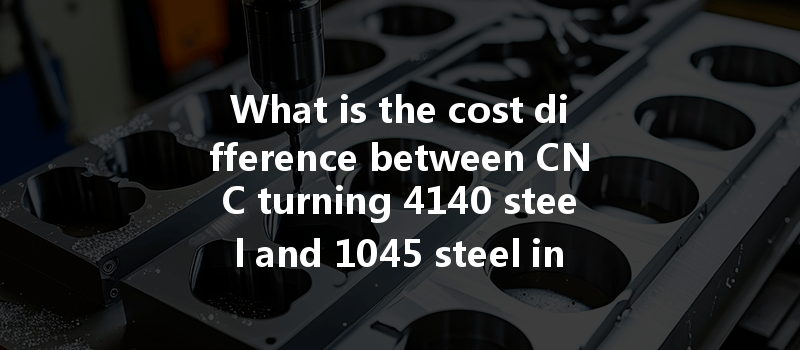Opening: Harnessing the Versatility of Steel in Manufacturing
Did you know that steel is one of the most widely used materials in the world? According to the World Steel Association, global crude steel production reached 1.86 billion tonnes in 2021 alone, underscoring its paramount importance in various manufacturing processes. However, when it comes to selecting the right type of steel for CNC turning operations, manufacturers often face a critical decision: Should they choose 4140 steel or 1045 steel? Understanding the cost difference and the factors influencing this choice not only impacts overall project budgets but also quality, durability, and performance.
The Importance of Choosing the Right Steel
When selecting the appropriate material for CNC turning, manufacturers must consider mechanical properties such as hardness, strength, and machinability. Notably, 4140 and 1045 steel each carry unique characteristics that render them suitable for different applications. As a result, understanding these distinctions can play a crucial role in optimizing production costs.
1.
4140 steel, also known as alloy steel, contains chromium and molybdenum, which enhance its heat treatment capabilities and wear resistance. This steel type is known for its high tensile strength, making it suitable for applications that require durability and resistance to deformation. Often used in manufacturing shafts, axles, and gears, 4140 steel tends to be the go-to choice for heavy-duty applications.
1.
1045 steel is classified as medium carbon steel, offering a good balance of strength and ductility. It is an affordable choice for many manufacturers due to its availability and ease of machining. Applications usually include gears, axles, and various structural components. While it may not offer the same level of hardness as 4140, its cost-effectiveness makes it highly appealing for numerous projects.
When comparing the costs associated with CNC turning 4140 steel and 1045 steel, several key factors come into play:
2.
The raw material costs for both types of steel can vary significantly, primarily due to their composition. Alloy steels like 4140 often command higher prices owing to the added alloying elements, which contribute to improved mechanical properties.
2.
CNC turning processes may differ based on the type of steel being machined. While 1045 steel tends to be more straightforward, utilizing less complex tooling and lower spindle speeds, 4140 steel can require specialized tools and programming due to its increased hardness and toughness. The increased wear on tooling and the necessity of slower feed rates can escalate machining costs.
2.
4140 steel can frequently undergo heat treatment processes, resulting in additional costs tied to these operations. Prepping the material for heat treatment requires proper planning and execution, while the heat-treated part can demonstrate better performance in demanding applications. Conversely, 1045 steel often requires less machining, lowering production costs.
2.
The required labor hours for machining will differ based on the complexities mentioned above. CNC operators may need additional skills and experience when working with 4140 steel, potentially increasing labor rates for those projects.
To further understand the cost implications of these materials, let’s explore a few practical applications that highlight the differences in cost and performance.
3.
When creating gears for high-load applications within machinery, opting for 4140 steel may justify the additional expense. The increased longevity and ability to withstand wear under intense conditions can lead to reduced maintenance costs over time. However, if the gears will operate under moderate loads, 1045 steel may be a more suitable choice—providing sufficient performance at a reduced cost.

3.
In the automotive industry, components such as axles and driveshafts require materials that can sustain high strain. The ability to customize 4140 with heat treatment for improved hardness can offer substantial advantages in performance; however, projects strongly influenced by budget constraints might find 1045 to be a perfectly acceptable alternative.
To elucidate the financial implications, let’s conduct a cost analysis considering a hypothetical batch of 1000 units each of CNC-turned parts from 4140 and 1045 steel.
4.
Let’s assume the following prices for simplicity:
For illustrative purposes, if each part weighs 2 pounds:
4.
Assuming the machining time and labor rates yield the following costs (including tooling overhead):
4.
From this analysis, machining 4140 steel costs approximately 51% more than machining 1045 steel for this specific project.
In the world of CNC turning, understanding the cost difference between 4140 steel and 1045 steel is just the starting point. Manufacturing decisions must weigh factors beyond mere price, including application requirements, material properties, machinability, and long-term performance. While 4140 steel can incur higher costs, its excellent wear resistance and durability might provide superior value in appropriate applications. Conversely, 1045 steel can be a cost-effective choice for projects where demand is less stringent.
In summary, the right choice of steel can lead to optimized budgets and improved project outcomes. Manufacturers must evaluate their specific needs and the life cycle costs associated with the materials they choose. By doing so, they not only enhance their production efficiency but also solidify their competitive edge in the manufacturing sector.
As you navigate your manufacturing challenges, take the time to reflect on the implications of your material selections. It’s not just a matter of cost—it’s also about achieving the right balance between performance and expenditure, an essential consideration in today’s competitive landscape.






